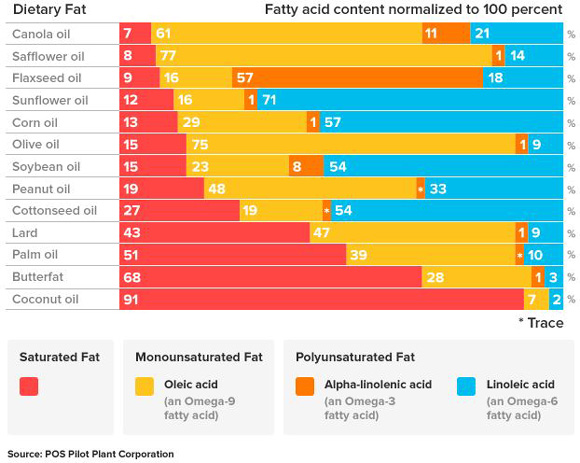Vitamin E Family
 Thursday, April 27, 2017 at 11:02AM
Thursday, April 27, 2017 at 11:02AM FYI: Over 99% of Multi-Vitamins contain only one out of 8 forms that make up nature's vitamin E family.
Here is what the NIH's ODS (Office of Dietary Supplements) has to say to Health Professionals about Vitamin E:
“Vitamin E” is the collective name for a group of fat-soluble compounds with distinctive antioxidant activities [1].
Naturally occurring vitamin E exists in eight chemical forms (alpha-, beta-, gamma-, and delta-tocopherol and alpha-, beta-, gamma-, and delta-tocotrienol) that have varying levels of biological activity [1]. Alpha- (or α-) tocopherol is the only form that is recognized to meet human requirements.* (Read on to discover why this is short-sighted)
Serum concentrations of vitamin E (alpha-tocopherol) depend on the liver, which takes up the nutrient after the various forms are absorbed from the small intestine. The liver preferentially resecretes only alpha-tocopherol via the hepatic alpha-tocopherol transfer protein [1]; the liver metabolizes and excretes the other vitamin E forms [2]. As a result, blood and cellular concentrations of other forms of vitamin E are lower than those of alpha-tocopherol and have been the subjects of less research [3,4]"
Contrast the preceding to the NIH's Vitamin E fact sheet for Consumers below:
"Vitamin E is a fat-soluble nutrient found in many foods. In the body, it acts as an antioxidant, helping to protect cells from the damage caused by free radicals. Free radicals are compounds formed when our bodies convert the food we eat into energy. People are also exposed to free radicals in the environment from cigarette smoke, air pollution, and ultraviolet light from the sun.
The body also needs vitamin E to boost its immune system so that it can fight off invading bacteria and viruses. It helps to widen blood vessels and keep blood from clotting within them. In addition, cells use vitamin E to interact with each other and to carry out many important functions."
Did you notice anything different in the descriptions? There was no mention of the vitamin E family members to Consumers. Now, after one reads the studies below and sees the benefits of consuming all the vitamin E family members, there is one question that should stand out. Why does the NIH want to limit vitamin E family health protections for Consumers, especially since the vitamin E family members combine together to work on the most pressing health issues facing consumers today, functions that vitamin E as d'alpha tocopherol by itself does not do or only has limited action? ref
NOTE: Here is NEW research on tocotrienols and disease published in 2022. ref
WHAT IS VITAMIN E AND WHY THE CONTROVERSY???
This article was added since the original title for this topic was changed and the search key comes up blank. Please read the article highlighted in the next paragraph to discover the new Science about vitamin E family. While the alpha form of tocopherol, vitamin E, is vitally important, the other three tocopherols and four tocotrienols have some unique and vital functions of their own plus they complement the alpha form. Well, actually, they can be converted into the alpha form in the body when more alpha is needed, but the alpha form does not convert into the others. Interesting twist for Nature. ref
MAJOR PRECAUTIONS EXIST FOR VITAMIN E
NOTE: This topic is controversial since the science has not quite settled many vitamin E form issues. First, nature puts the family of 4 tocopherols together in food. The majority of supplements use just one, Alpha tocopherol, and almost never any of the four vitamin E family members from the tocotrienol group. Do the other three tocopherols and the four tocotrienols have vital functions needed by the body? Scientists are only now looking into the functions of these other natural vitamin E family forms. Some interesting positive results are mentioned next. Additionally, check out this breast cancer connection. ref ref How could the ODS have failed to see significance in the whole family of Vitamin E members? Ignoring at least 25 years of study. ref There is a logical though flawed explanation.*
FYI: This Oregon University website article has great and clear info on vitamin E.
There are other articles on this website (Vitamin E Family in Health and Disease) that cover aspects of this important topic. Vitamin E exists in nature in 4 tocopherol forms and 4 tocotrienol forms, as alpha, beta, delta, and gamma. In the 1940's, the FDA made a decision between two forms, a mixture of all 8 natural forms, or just the alpha tocopherol form to call vitamin E and be given vitamin E units.
The single alpha tocopherol form won out. Plus, to add insult to injury, the FDA also decided that the newly manufactured synthetic form of vitamin E, dl'alpha tocopheryl acetate, would be used to set the one unit amount of vitamin E. It is interesting to note that even at that time, Scientists saw that there was a difference between the natural and synthetic forms in activity.
The natural was more active and while 1 mg of the synthetic was set at 1 unit, it only took .67mg of the natural to equal. This was determined from a study on dogs. A much later human study puts it at about .50 mg. Any Professional today who says the 2 different forms are equal is really saying they are equal only if you compare different amounts. The 7 other members of the vitamin E family were not even allowed to be given any vitamin E unit values or even called vitamin E. ref
To this day, this remains one of the biggest mistakes of mainstream nutrition. Since Scientists don't like to admit they made such an egregious error and it is still being covered up and significantly kept from Public awareness.
DO NOT CONSUME OVER 300IU OF VITAMIN E as just D'alpha tocopherol without the other 3 tocopherols listed and at least some amount specified. Plus, NEVER take the synthetic form of vitamin E, listed as dl'alpha tocopheryl. The exact healthy ratio between the four tocopherols is not yet known. There are balance points that need respecting.
The issue here is that taking just the one form of vitamin E, whether natural or synthetic, becomes competitive for absorption in the digestive tract and the other 7 vitamin E family forms, arriving just in food, can get blocked out. This is what happened in the SELECT study. The body needs more than just the alpha tocopherol form to effectively deal with all types of free radicals. The alpha form deals effectively with oxygen generated free radicals, but it is another form from the vitamin E family, gamma tocopherol that handles nitrogen generated free radicals, Both forms of radicals attack prostate tissues. When the body needs more alpha tocopherol, it can convert the gamma form into alpha form, but not vice versa. And check out this tocotrienol study on cardiovascular disease and ageing. ref And tocotrienols on protecting nerve cells and brain functions. ref This study suggests tocotrienols should have their own vitamin classification due to their unique functions other than as an anti-oxidant. ref
MULTIPLES FAIL TO MAXIMIZE VITAMIN E FORMS
Over 95% of Multiples Vitamins in the marketplace today fail to provide the "complete" E family forms. Even the whole food vitamin forms fail in this category.
This one example from a Rutgers University study result will provide clues as to the precautions mentioned above. In 2012, Yang & colleagues stated "that animal studies on colon, lung, breast, and prostate cancers found that gamma and delta tocopherols prevented cancer formation and growth...while the vitamin E form, d'alpha tocopherol, provided no such benefit." ref ref ref ref
Adding to this info that the other 3 vitamin E family tocopherols members are more effective against cancers than d-alpha tocopherol, check out this study on the other half of the vitamin E family, the tocotrienols. ref ref
Disclaimer: Many of these studies are on animals or in test tubes. These results are not always duplicated inside humans, but serve more to give direction and possibilities. There are some human studies and these should carry more weight. ref article
OF INTEREST
The US Natural Institutes of Health, Office of Dietary Supplements, Professionals not only know about these vitamin E family functions, it was ODS grant money that funded many of the research studies. Thus, the question is more about the failure of the NIH to share this new vital vitamin information on their vitamin information sheets with the vitamin consuming Public. ref <consumers ref <professionals. There must be other factors governing why beyond that of safeguarding the health of the Public. Check out this Grant study abstract application and details about testing vitamin E family forms on breast cancer. ref
Now, why the ODS fact sheets do not mention the other family members of vitamin E becomes that much more of an enigma. What were the results of this study?
COULD VITAMIN E STORY REALLY BE THIS SIMPLE
The alpha tocopherol form, the only one called vitamin E out of 8 related family members fround in nature, works great to neutralize oxygen radicals, or ROS. This is necessary for redox balance. But alpha tocopherol does not work against nitrogen radicals, RNS. It is the Gamma tocopherol form that neuralizes RNS. Elements formed from these two radicals interact or cross-talk to control other processes. ref A balance between the two is needed. ref If only alpha tocopherol is present in supplements (98%), it is possible that this would result in greater amounts of ROS neutralized compared to RNS and the balance point between them would be broken. The body would work overtime to correct, but eventually could fail. This would especially impact heart disease, cancers, and brain health. ref
The take away here is that only using alpha tocopherol for vitamin E is short-sighted. ROS and RNS are naturally formed by normal body processes as well as by added stressors. ROS and RNS radicals both have good and bad actions that need to be balanced and controlled by proper generation of antioxidants inside the body as well as from supplements depending upon certain other factors, diet, lifestyle, body genetics, environmentals, etc.
* There are two reasons that support the alpha tocopherol is the only form given human need. First, it is the only one of the 8 vitamin E family members that attaches to it's own specific and protective protein transporter in the blood stream. (Well, new information has a-T with 100% attraction to aTTP, and a few other vitamin E members also attach but at quite lower percentages.) And two, it is the only one that will be found in the blood stream after a few days. Thus, early Scientists though it was the only one needed. One more fact later discovered also added to this view, the other vitamin E members can covert in the body into the alpha tocopherol form when more of it is needed. But the alpha tocopherol form does not convert into the other forms. Obviously, Nature knew the alpha tocopherol form was important to be near where oxygen was most abundant, mainly in the blood stream, since alpha tocopherol is a vital reactive oxygen radical neutralizer. But, the story does not stop here for the other 7 vitamin E family forms as many of the articles and linked studies reveal. Many of the beneficial functions of these other 7 are beyond the scope of the actions of alpha tocpherol by itself. It's not nice to fool with Mother Nature.
VITAMIN E SUPPLEMENTS AND BLOOD PLASMA LEVELS
This is a very important area in helping to understand vitamin E family dosage levels. The body knows that alpha tocopherol is very important to protect elements from oxidation and adds a protein transport carrier to hold alpha tocopherol where the most oxygen is found, in the blood, and then in cells. The amount of the other 3 tocopherols is very low in blood, but higher in glands and cells, plus fat cells. The typical ratio found in blood between alpha and gamma tocopherols is over 20 to 1.
Gamma tocopherol protects against nitrogen oxides. These can damage DNA in cells. Protein, amino acids, that repair and build new body structures contains nitrogen. The digestion system uses a lot of nitrogen. And then remember, if the body needs more alpha tocopherol, such as due to over consuming polyunsaturated oils, the body can convert gamma, beta, and delta tocopherols into the alpha form, but not vice versa. Plus, recall that consuming high amounts of alpha tocopherol in supplements reduces body levels of gamma tocopherol arriving from foods.
The exact amounts of the vitamin E family members to consume is still under debate. ref The American diet contains a lot of gamma tocopherol, maybe too much. And too many of certain dietary vegetable oils and fats increase the need for and use up alpha tocopherol. Best to analyze dietary food ratios and go from there. Dietary food nutrient surveys in America reveal a large percentge of the population is low in vitamin E as alpha tocopherol and very likely the other three tocopherols and especially the four tocotrienols. While a smaller minority over consume foods with certain vitamin E forms at the expense of others.
Determining Ratios of Vitamin E family members
Precaution: While all the different forms of vitamin E family have roles in health, it is important to respect natural ratios and not overdue, especially the alpha to gamma tocopherol levels. The exact ratios are still under debate. It may be that different health conditions may need different levels. But an overall ratio is probably best to satisfy most conditions.
Precaution 2: There are studies showing a negative association of higher gamma tocopherol levels for some breast cancer research. Rmember, that these are mainly from just looking at dietary sources wtih a blood analysis to determine levels. Unfortunately, diets high in safflower, corn, and soy oils will yield higher gamma tocohperol levels. It may very well be the higher vegetable oil fat omega 6 ratio to omega 3 that is the real factor and not the gamma levels that cause the negative assocation. ref article
Another article. Real Vitamin E


